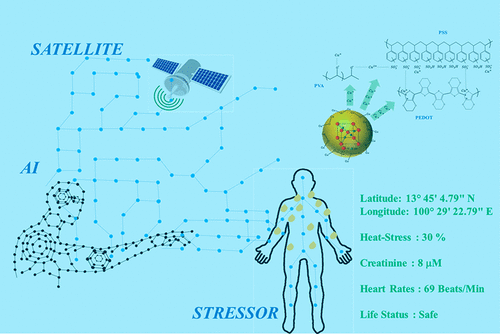当前位置:
X-MOL 学术
›
ACS Biomater. Sci. Eng.
›
论文详情
Our official English website, www.x-mol.net, welcomes your
feedback! (Note: you will need to create a separate account there.)
Satellite-Based Sensor for Environmental Heat-Stress Sweat Creatinine Monitoring: The Remote Artificial Intelligence-Assisted Epidermal Wearable Sensing for Health Evaluation
ACS Biomaterials Science & Engineering ( IF 5.4 ) Pub Date : 2020-12-23 , DOI: 10.1021/acsbiomaterials.0c01459 Surachate Kalasin 1 , Pantawan Sangnuang 2 , Werasak Surareungchai 2, 3
ACS Biomaterials Science & Engineering ( IF 5.4 ) Pub Date : 2020-12-23 , DOI: 10.1021/acsbiomaterials.0c01459 Surachate Kalasin 1 , Pantawan Sangnuang 2 , Werasak Surareungchai 2, 3
Affiliation

|
Wearable human sweat sensors have offered a great prospect in epidermal detection for self-monitoring and health evaluation. These on-body epidermal sensors can be integrated with the Internet of Things (IoT) as augmented diagnostics tools for telehealth applications, especially for noninvasive health monitoring without using blood contents. One of many great benefits in utilizing sweat as biofluid is the capability of instantaneously continuous diagnosis during normal day-to-day activities. Here, we revealed a textile-based sweat sensor selective for perspired creatinine that is prepared by coating poly(vinyl alcohol) (PVA)-Cu2+-poly(3,4-ethylenedioxythiophene) polystyrenesulfonate (PEDOT:PSS) and cuprous oxide nanoparticles on stretchable nylon, is equipped with heart rate monitoring and a satellite-communication device to locate wearers, and incorporates machine learning to predict the levels of environmental heat stress. Electrochemical impedance spectroscopy (EIS) was used to investigate different charge-transfer resistances of PVA and PEDOT:PSS with cuprous and cuprite ions induced by single-chain and ionic cross-linking. Furthermore, density function theory (DFT) studies predicted the catalytic binding of sweat creatinine with the sensing materials that occurred at thiophene rings. The hybrid sensor successfully achieved 96.3% selectivity efficacy toward the determination of creatinine contents from 0.4 to 960 μM in the presence of interfering species of glucose, urea, uric acid, and NaCl as well as retained 92.1% selectivity efficacy in the existence of unspecified human sweat interference. Ultimately, the hand-grip portable device can offer the great benefit of continuous health monitoring and provide the location of any wearer. This augmented telemedicine sensor may represent the first remote low-cost and artificial-intelligence-based sensing device selective for heat-stress sweat creatinine.
中文翻译:

基于卫星的环境热应激肌酐监测传感器:远程人工智能辅助的表皮可穿戴式健康评估
可穿戴的人类汗液传感器在表皮检测中为自我监测和健康评估提供了广阔的前景。这些人体表皮传感器可以与物联网(IoT)集成在一起,作为远程医疗应用程序的增强诊断工具,尤其是在不使用血液的情况下进行无创健康监测的情况。利用汗液作为生物流体的许多重大好处之一就是能够在正常的日常活动中进行即时连续诊断。在这里,我们揭示了一种基于纺织品的汗液传感器,该传感器对汗液肌酐具有选择性,该传感器是通过涂覆聚乙烯醇(PVA)-Cu 2+-可拉伸尼龙上的聚(3,4-乙撑二氧噻吩)聚苯乙烯磺酸盐(PEDOT:PSS)和氧化亚铜纳米粒子,配有心率监测器和卫星通讯设备以定位佩戴者,并结合了机器学习功能来预测环境热量的水平强调。电化学阻抗谱(EIS)用于研究PVA和PEDOT:PSS在单链和离子交联引起的亚铜和亚铜离子的作用下的不同电荷转移电阻。此外,密度泛函理论(DFT)研究预测出汗肌酐与噻吩环处的传感材料之间的催化结合。在存在葡萄糖干扰物质的情况下,该混合传感器成功地实现了96.3%的选择性功效,可测定0.4至960μM的肌酐含量,尿素,尿酸和NaCl以及在不确定的人类汗液干扰下仍保留92.1%的选择性功效。最终,手持便携式设备可以提供连续健康监测的巨大好处,并可以提供任何佩戴者的位置。这种增强的远程医学传感器可以代表第一类针对热应激汗肌酐选择性的远程低成本和基于人工智能的传感设备。
更新日期:2021-01-11
中文翻译:

基于卫星的环境热应激肌酐监测传感器:远程人工智能辅助的表皮可穿戴式健康评估
可穿戴的人类汗液传感器在表皮检测中为自我监测和健康评估提供了广阔的前景。这些人体表皮传感器可以与物联网(IoT)集成在一起,作为远程医疗应用程序的增强诊断工具,尤其是在不使用血液的情况下进行无创健康监测的情况。利用汗液作为生物流体的许多重大好处之一就是能够在正常的日常活动中进行即时连续诊断。在这里,我们揭示了一种基于纺织品的汗液传感器,该传感器对汗液肌酐具有选择性,该传感器是通过涂覆聚乙烯醇(PVA)-Cu 2+-可拉伸尼龙上的聚(3,4-乙撑二氧噻吩)聚苯乙烯磺酸盐(PEDOT:PSS)和氧化亚铜纳米粒子,配有心率监测器和卫星通讯设备以定位佩戴者,并结合了机器学习功能来预测环境热量的水平强调。电化学阻抗谱(EIS)用于研究PVA和PEDOT:PSS在单链和离子交联引起的亚铜和亚铜离子的作用下的不同电荷转移电阻。此外,密度泛函理论(DFT)研究预测出汗肌酐与噻吩环处的传感材料之间的催化结合。在存在葡萄糖干扰物质的情况下,该混合传感器成功地实现了96.3%的选择性功效,可测定0.4至960μM的肌酐含量,尿素,尿酸和NaCl以及在不确定的人类汗液干扰下仍保留92.1%的选择性功效。最终,手持便携式设备可以提供连续健康监测的巨大好处,并可以提供任何佩戴者的位置。这种增强的远程医学传感器可以代表第一类针对热应激汗肌酐选择性的远程低成本和基于人工智能的传感设备。











































 京公网安备 11010802027423号
京公网安备 11010802027423号